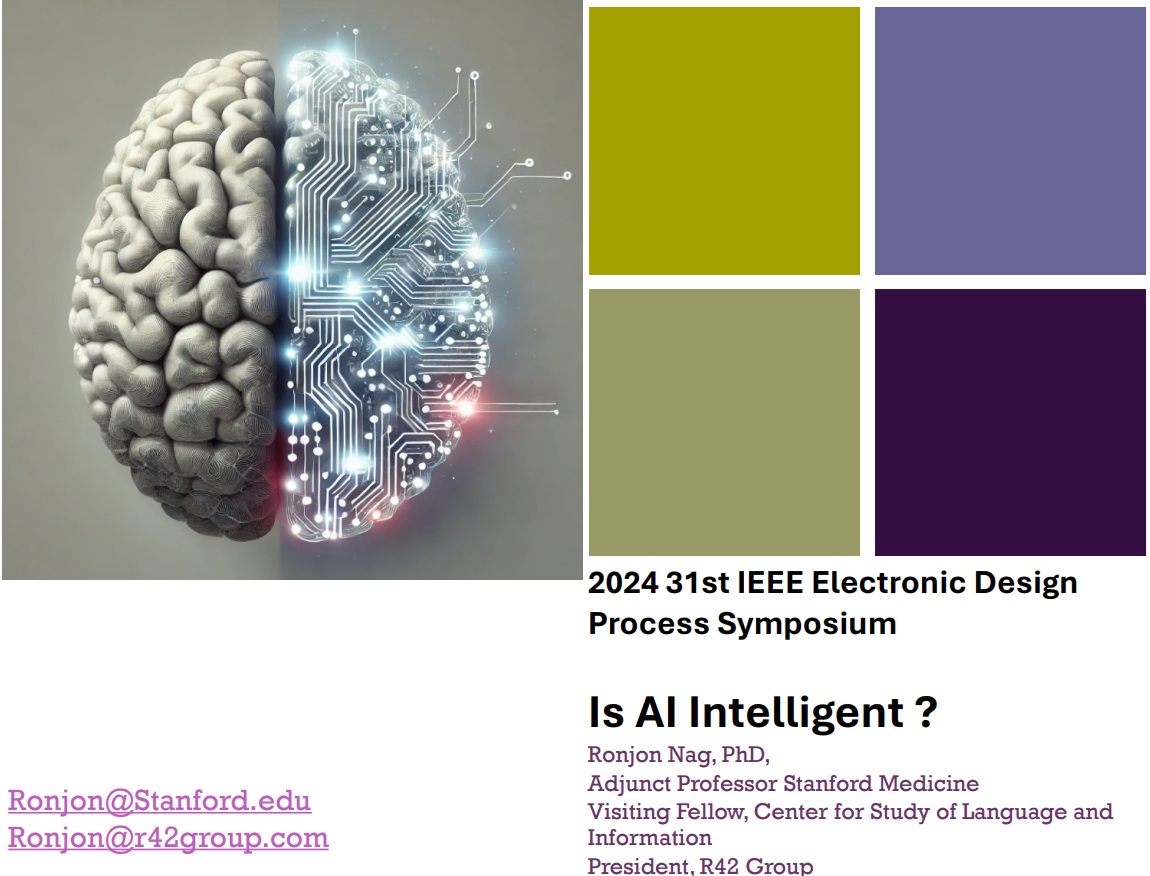
In his keynote at the 2024 31st IEEE Electronic Design Process Symposium, Dr. Ronjon Nag, an adjunct professor at Stanford Medicine and president of the R42 Group, poses the provocative question: “Is AI Intelligent?” Drawing from four decades of pioneering work in AI, Nag blends personal anecdotes, scientific analysis, and philosophical inquiry to explore the essence of intelligence in humans, animals, and machines. As an inventor who founded companies like Lexicus (sold to Motorola) and Cellmania (sold to BlackBerry), and an investor in over 100 AI and biotech ventures, Nag’s credentials lend weight to his multidisciplinary perspective.
Nag begins by unpacking intelligence beyond the familiar IQ metric. He highlights alternative quotients: Emotional Intelligence from Daniel Goleman, Ambition Quotient, Purpose Quotient from John Gottman, Compassion Quotient, and Freedom Quotient. These underscore that intelligence isn’t monolithic but encompasses emotional, social, and existential dimensions. In daily life, AI already manifests intelligently through applications like Siri, Alexa, robotic vacuum cleaners, collision avoidance systems, loan scoring algorithms, and stock market predictors. Yet, Nag clarifies terminology to avoid confusion: “Good Old Fashioned AI” refers to rule-based systems; Machine Learning involves data-driven algorithms like logistic regression and neural networks; Artificial Intelligence is the broader academic field; and Generalized AI or Strong AI implies human-level performance across any task.
A core comparison lies in biological versus artificial brains. Nag illustrates natural neural networks, where signals propagate through neurons, contrasting this with simplified computational models like weighted sums and sigmoid functions. The human brain boasts 100 billion neurons, each connected to about 1,000 others, yielding 100 trillion parameters. In contrast, GPT-4 operates with “only” 1.6 trillion parameters, highlighting AI’s efficiency despite its scale. Nag notes AI’s creative feats, such as generating paintings, but questions why AGI hasn’t been declared. Reasons include skepticism about metrics, ideological biases toward alternative theories, human exceptionalism, and economic fears.
Delving into the “Boundaries of Humanity” project at Stanford, Nag examines what distinguishes humans. Cultural intelligence—social learning, imitation, morality, and rituals—sets us apart, though contested in animals like chimpanzees (who exhibit community standards) and dolphins (with dialects and cooperative hunting). Machines store raw data and commentary (e.g., Amazon reviews), but encoding higher-order culture like morals remains challenging, potentially clashing with survival-oriented objectives.
Consciousness emerges as a pivotal debate. Nag asks: Can machines have minds? Strong AI posits yes, encompassing consciousness, sentience, and self-awareness, while Weak AI focuses on simulation. He references John Searle’s Chinese Room argument: a person copying Chinese symbols without understanding them mirrors computers following instructions sans comprehension. Alternative theories include quantum mind ideas from Roger Penrose and Stuart Hameroff, where microtubules enable wave function collapses for consciousness, or neurobiological views from Christof Koch and Francis Crick locating it in the prefrontal cortex. The Turing Test gauges human-like conversation but not consciousness; Nag proposes the Artificial Consciousness Test, probing AI’s grasp of experiential concepts like body-switching or reincarnation.
Humans excel in world understanding, action prediction, unlimited reasoning, and task decomposition—areas where Large Language Models (LLMs) falter. For AI’s future, Nag envisions neuromorphic chips outperforming GPUs by integrating on-chip memory and low-precision arithmetic. Emotions, per Antonio Damasio’s somatic marker hypothesis, evaluate stimuli via bodily responses; implementing them in AI could involve haptic technologies, as in robotic seals aiding dementia patients.
Nag ties AI to longevity, noting parallel inflection points: from Turing machines to ChatGPT in AI, and vaccines to CRISPR in biotech. By 2025, personalized AI healthcare and aging vaccines could converge. Ultimately, Nag argues AI is intelligent in narrow domains but lacks holistic human qualities. His talk invites reflection: as we augment ourselves (e.g., via implants), boundaries blur. Contact him at https://app.soopra.ai/ronjon/chat for deeper dialogue.
2025 IEEE Electronic Design Process Symposium (EDPS)
Share this post via:






The Quantum Threat: Why Industrial Control Systems Must Be Ready and How PQShield Is Leading the Defense